Related Research Articles

Fracture is the appearance of a crack or complete separation of an object or material into two or more pieces under the action of stress. The fracture of a solid usually occurs due to the development of certain displacement discontinuity surfaces within the solid. If a displacement develops perpendicular to the surface, it is called a normal tensile crack or simply a crack; if a displacement develops tangentially, it is called a shear crack, slip band, or dislocation.
The field of strength of materials typically refers to various methods of calculating the stresses and strains in structural members, such as beams, columns, and shafts. The methods employed to predict the response of a structure under loading and its susceptibility to various failure modes takes into account the properties of the materials such as its yield strength, ultimate strength, Young's modulus, and Poisson's ratio. In addition, the mechanical element's macroscopic properties such as its length, width, thickness, boundary constraints and abrupt changes in geometry such as holes are considered.

A strain gauge is a device used to measure strain on an object. Invented by Edward E. Simmons and Arthur C. Ruge in 1938, the most common type of strain gauge consists of an insulating flexible backing which supports a metallic foil pattern. The gauge is attached to the object by a suitable adhesive, such as cyanoacrylate. As the object is deformed, the foil is deformed, causing its electrical resistance to change. This resistance change, usually measured using a Wheatstone bridge, is related to the strain by the quantity known as the gauge factor.
Stress–strain analysis is an engineering discipline that uses many methods to determine the stresses and strains in materials and structures subjected to forces. In continuum mechanics, stress is a physical quantity that expresses the internal forces that neighboring particles of a continuous material exert on each other, while strain is the measure of the deformation of the material.

Photogrammetry is the science and technology of obtaining reliable information about physical objects and the environment through the process of recording, measuring and interpreting photographic images and patterns of electromagnetic radiant imagery and other phenomena.
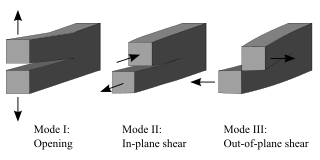
Fracture mechanics is the field of mechanics concerned with the study of the propagation of cracks in materials. It uses methods of analytical solid mechanics to calculate the driving force on a crack and those of experimental solid mechanics to characterize the material's resistance to fracture.
Particle image velocimetry (PIV) is an optical method of flow visualization used in education and research. It is used to obtain instantaneous velocity measurements and related properties in fluids. The fluid is seeded with tracer particles which, for sufficiently small particles, are assumed to faithfully follow the flow dynamics. The fluid with entrained particles is illuminated so that particles are visible. The motion of the seeding particles is used to calculate speed and direction of the flow being studied.
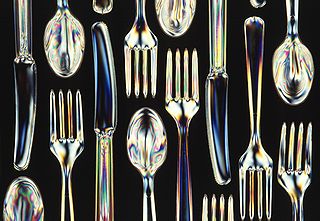
In materials science, photoelasticity describes changes in the optical properties of a material under mechanical deformation. It is a property of all dielectric media and is often used to experimentally determine the stress distribution in a material.
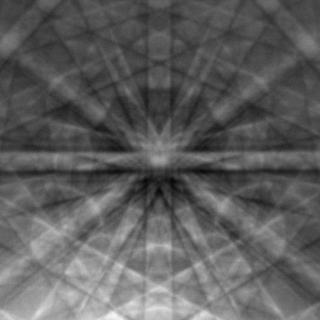
Electron backscatter diffraction (EBSD) is a scanning electron microscopy (SEM) technique used to study the crystallographic structure of materials. EBSD is carried out in a scanning electron microscope equipped with an EBSD detector comprising at least a phosphorescent screen, a compact lens and a low-light camera. In the microscope an incident beam of electrons hits a tilted sample. As backscattered electrons leave the sample, they interact with the atoms and are both elastically diffracted and lose energy, leaving the sample at various scattering angles before reaching the phosphor screen forming Kikuchi patterns (EBSPs). The EBSD spatial resolution depends on many factors, including the nature of the material under study and the sample preparation. They can be indexed to provide information about the material's grain structure, grain orientation, and phase at the micro-scale. EBSD is used for impurities and defect studies, plastic deformation, and statistical analysis for average misorientation, grain size, and crystallographic texture. EBSD can also be combined with energy-dispersive X-ray spectroscopy (EDS), cathodoluminescence (CL), and wavelength-dispersive X-ray spectroscopy (WDS) for advanced phase identification and materials discovery.
Discontinuous deformation analysis (DDA) is a type of discrete element method (DEM) originally proposed by Shi in 1988. DDA is somewhat similar to the finite element method for solving stress-displacement problems, but accounts for the interaction of independent particles (blocks) along discontinuities in fractured and jointed rock masses. DDA is typically formulated as a work-energy method, and can be derived using the principle of minimum potential energy or by using Hamilton's principle. Once the equations of motion are discretized, a step-wise linear time marching scheme in the Newmark family is used for the solution of the equations of motion. The relation between adjacent blocks is governed by equations of contact interpenetration and accounts for friction. DDA adopts a stepwise approach to solve for the large displacements that accompany discontinuous movements between blocks. The blocks are said to be "simply deformable". Since the method accounts for the inertial forces of the blocks' mass, it can be used to solve the full dynamic problem of block motion.
Digital image correlation and tracking is an optical method that employs tracking and image registration techniques for accurate 2D and 3D measurements of changes in images. This method is often used to measure full-field displacement and strains, and it is widely applied in many areas of science and engineering. Compared to strain gauges and extensometers, digital image correlation methods provide finer details about deformation, due to the ability to provide both local and average data.
MEMS for in situ mechanical characterization refers to microelectromechanical systems (MEMS) used to measure the mechanical properties of nanoscale specimens such as nanowires, nanorods, whiskers, nanotubes and thin films. They distinguish themselves from other methods of nanomechanical testing because the sensing and actuation mechanisms are embedded and/or co-fabricated in the microsystem, providing—in the majority of cases—greater sensitivity and precision.
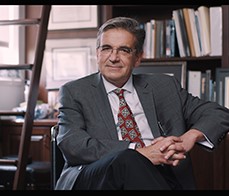
Ares J. Rosakis, Theodore von Kármán Professor of Aeronautics and Professor of Mechanical Engineering at the California Institute of Technology. He was also the fifth Director of the Graduate Aerospace Laboratories, known as (GALCIT), and formerly known as Guggenheim Aeronautical Laboratory, and was the Otis Booth Leadership Chair, of the Division of Engineering and Applied Science.

Crack tip opening displacement (CTOD) or is the distance between the opposite faces of a crack tip at the 90° intercept position. The position behind the crack tip at which the distance is measured is arbitrary but commonly used is the point where two 45° lines, starting at the crack tip, intersect the crack faces. The parameter is used in fracture mechanics to characterize the loading on a crack and can be related to other crack tip loading parameters such as the stress intensity factor and the elastic-plastic J-integral.
Cesar Augusto Sciammarella is an Argentine civil engineer who made significant contributions to the field of experimental mechanics. In the last decade, he has extended his pioneering developments in moiré, holography, and speckle interferometry methodologies down to the nanometer level. These efforts have enabled optics to be applied beyond the classical Rayleigh limit, reaching the nanometer range.
Traction force microscopy (TFM) is an experimental method for determining the tractions on the surface of a biological cell by obtaining measurements of the surrounding displacement field within an in vitro extracellular matrix (ECM).
YaDICs is a program written to perform digital image correlation on 2D and 3D tomographic images. The program was designed to be both modular, by its plugin strategy and efficient, by it multithreading strategy. It incorporates different transformations, optimizing strategy, Global and/or local shape functions ...
Digital image correlation analyses have applications in material property characterization, displacement measurement, and strain mapping. As such, DIC is becoming an increasingly popular tool when evaluating the thermo-mechanical behavior of electronic components and systems.

In materials science and solid mechanics, biaxial tensile testing is a versatile technique to address the mechanical characterization of planar materials. It is a generalized form of tensile testing in which the material sample is simultaneously stressed along two perpendicular axes. Typical materials tested in biaxial configuration include metal sheets, silicone elastomers, composites, thin films, textiles and biological soft tissues.
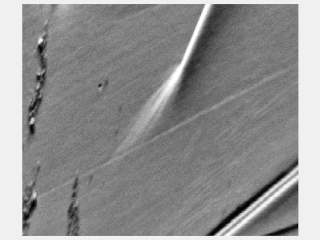
Slip bands or stretcher-strain marks are localized bands of plastic deformation in metals experiencing stresses. Formation of slip bands indicates a concentrated unidirectional slip on certain planes causing a stress concentration. Typically, slip bands induce surface steps and a stress concentration which can be a crack nucleation site. Slip bands extend until impinged by a boundary, and the generated stress from dislocations pile-up against that boundary will either stop or transmit the operating slip depending on its (mis)orientation.
References
- ↑ "ASTM E2472 - 12(2018) Standard Test Method for Determination of Resistance to Stable Crack Extension under Low-Constraint Conditions". www.astm.org.
- ↑ "Past Recipients". RE Peterson Award.
- ↑ Luo, PF.; et al. (June 1993). "Accurate measurement of three-dimensional deformations in deformable and rigid bodies using computer vision". Experimental Mechanics . 33 (2): 123–132. doi:10.1007/BF02322488. S2CID 136427692.
- ↑ Luo, PF.; et al. (1 March 1994). "Application of stereo vision to three-dimensional deformation analyses in fracture experiments". Optical Engineering. 33 (3): 981–990. Bibcode:1994OptEn..33..981L. doi:10.1117/12.160877.
- ↑ Helm, JD.; et al. (July 1996). "Improved three-dimensional image correlation for surface displacement measurement". Optical Engineering. 35 (7): 1911–1920. Bibcode:1996OptEn..35.1911H. doi:10.1117/1.600624.
- ↑ Helm, JD.; et al. (May 2003). "Deformations in wide, center-notched, thin panels, part I: three-dimensional shape and deformation measurements by computer vision". Optical Engineering. 42 (5): 1293–1320. Bibcode:2003OptEn..42.1293H. doi:10.1117/1.1566001.
- ↑ McNeil, SR.; et al. Experimental evaluation of surface deformations in three areas of a Boeing 727 aircraft due to internal pressure and tail loading, Report USC ME-1-1997 (Report).
- ↑ Sutton, MA.; et al. (January 2017). "Recent Progress in Digital Image Correlation: Background and Developments since the 2013 W M Murray Lecture". Experimental Mechanics . 57 (1): 1–30. doi:10.1007/s11340-016-0233-3. S2CID 255168149.
- ↑ Guo, SM.; et al. (January 2017). "Measurement of Local Thermal Deformations in Heterogeneous Microstructures via SEM Imaging with Digital Image Correlation". Experimental Mechanics . 57 (1): 41–56. doi:10.1007/s11340-016-0206-6. S2CID 255163320.
- ↑ Wang, Y.; et al. (14 July 2011). "Development of a quantitative mechanical test of atherosclerotic plaque stability". Journal of Biomechanics. 44 (13): 2439–45. doi:10.1016/j.jbiomech.2011.06.026. PMC 3156298 . PMID 21757197.
- ↑ Wang, Y.; et al. (22 Feb 2013). "Adhesive strength of atherosclerotic plaque in a mouse model depends on local collagen content and elastin fragmentation". Journal of Biomechanics. 46 (14): 716–22. doi:10.1016/j.jbiomech.2012.11.041. PMC 3568211 . PMID 23261250.
- ↑ Rajan, S.; et al. (13 Dec 2017). "A Stereovision Deformation Measurement System for Transfer Length Estimates in Prestressed Concrete". Experimental Mechanics. 58 (7): 1035–48. doi:10.1007/s11340-017-0357-0. S2CID 255162882.
- ↑ Högberg, JL.; et al. (15 December 2007). "Constitutive behaviour of mixed mode loaded adhesive layer". International Journal of Solids and Structures. 44 (25–26): 8335–54. doi: 10.1016/j.ijsolstr.2007.06.014 .
- ↑ "Society for Experimental Mechanics". sem.org.
- ↑ "Society for Experimental Mechanics". sem.org.
- ↑ "Society for Experimental Mechanics". sem.org.
- ↑ "ASME Fellow" (PDF).
- ↑ "Society for Experimental Mechanics". sem.org.
- ↑ "Society for Experimental Mechanics". sem.org.
- ↑ "Society for Experimental Mechanics". sem.org.
- ↑ William M. Murray Medalist acceptance lecture
- ↑ "Society for Experimental Mechanics". sem.org.
- ↑ "National Academy of Engineering Elects 86 Members and 18 International Members". NAE Website. Retrieved 2023-07-17.
- ↑ "Timoshenko Medal". www.asme.org. Retrieved 2023-07-17.
- ↑ Timoshenko Medal acceptance lecture